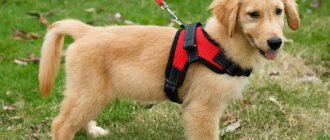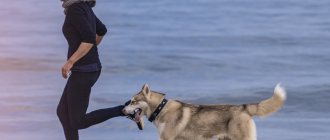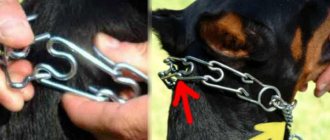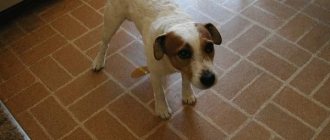19.06.2018
Getting used to a leash is one of the most important steps in raising a dog, because even the smallest and most domestic pets occasionally go out for walks, where they have to be restrained in their attempts to escape or meet other people.
If this question is also very relevant for you, take a couple of minutes to read our material, from which you will learn how to teach a dog to walk on a leash.
In general, before we begin, it is worth noting that there are two situations in life:
- I need to train my puppy to use a leash,
- I need to train an adult (over 1 year old) dog.
All of the following is approximately equally true for both cases, so we strongly recommend that you familiarize yourself with the following rules for both owners of puppies and adult dogs.
Why is it important
During walks, the owner must fully control his pet: the dog may run out onto the roadway, encounter aggressive animals, or be frightened by loud sounds and run away. In addition, representatives of large breeds can cause inconvenience to the people around them; walking them without a muzzle and a leash will result in a fine.
An untrained dog may react aggressively to new accessories: the collar will cause discomfort on the neck at first, and the leash will make it impossible to go wherever it wants, so you need to gradually accustom dogs to a leash.
At what age should I start?
You can teach a dog to walk “correctly” at any age, however, the younger the dog, the easier it is to train. Dog trainers advise puppies to be accustomed to a leash from 3 months, and to a collar no later than 8 weeks.
When the puppies are 7–10 days old, breeders, in order to distinguish the babies, mark them with multi-colored ribbons: this is how the dog gets used to new sensations on the neck from childhood. By two months, the bandage can be changed to a light collar.
You can take your pet outside only after vaccination, which is carried out at 2.5-3 months. They begin to fasten the leash from the second or third walk: the puppy needs time to get used to the new environment, smells and external stimuli, so the first walk is for the purpose of getting to know each other, not training.
Choosing a Collar
The choice of collar is of great importance. Keep in mind that the dog will grow, and for the first lessons there is no need to choose expensive, special equipment. The most comfortable will be a flat and lightweight collar that will not cause discomfort.
Avoid chain-shaped collars; a small puppy will most likely not want to wear one, because hair fibers getting into the chain links cause considerable discomfort.
How to choose an accessory
Ammunition should be selected based on the size and breed of the animal. Small dogs need accessories made from thin, lightweight materials, while large dogs need accessories made from tougher ones.
If the puppy has long hair, then the collar and leash should be smooth so that the hair does not pull out. Options with chains or spikes are not suitable for children: they are too rough and heavy.
The collar will always be in contact with the pet’s neck, so you need to choose it responsibly.
- In the first 2-3 months, when you are just starting to accustom your puppy to a collar, choose products made of nylon material with plastic fasteners: they are practically not felt on the neck.
- Babies grow quickly, so it is more profitable to take an adjustable collar, but make sure that the remaining edge does not stick out too much and does not interfere with the pet.
- Do not tighten the accessory too tightly. Two fingers should fit freely between the collar and neck.
- When the puppy gets used to the “baby” collar, replace it with a product made of canvas or synthetics. There is no need to use rough, low-quality leather or leatherette: over time, this material will become rough and crack, which will cause discomfort in the dog.
- The most comfortable collar design is European. The clasp is located at the bottom, and the ring for the leash is on the side: this prevents hair from being pulled out and does not allow the animal to shake its head during walks.
- To prevent the collar from rubbing your pet's neck, choose a product with a soft fleece or felt lining.
With the help of a leash, the owner will control the puppy on the street, so the product should be comfortable for both the animal and the owner:
- choose models made of nylon or canvas: they are light, but at the same time quite strong;
- the ideal leash length is 1.5-2 meters;
- the clasp must be securely attached to the collar so that the puppy does not fall off the leash;
- give up tape measures: they make it more difficult to control the animal;
- a leash in the form of a metal chain is inconvenient to hold and wrap around your hand, and such an accessory will be too heavy for a puppy.
Do not buy thin harnesses: the dog may jerk sharply and damage the fragile chest. As an alternative, you can consider vest harnesses: they apply soft, even pressure.
Manufacturers and prices
When choosing ammunition for your quadruple friend, it is important to find a quality product that meets all the requirements of both the owner and the animal. However, the first leash will soon have to be replaced with an “adult” model, so when buying debut equipment, it is important not to overpay, but to purchase a reliable product.
The products of the Italian company Ferplast have proven themselves to be excellent. It makes sense to buy products from the German company Flexi. Any model of leash can be found in the assortment of the Dutch brand Roller.
Flexi products
Driver leashes
The advantage of a simple leash is the maneuverability when controlling the dog. The disadvantage of the model is the need to wrap the free end around the hand or hold it with the other hand. The chain-driver can injure the owner’s hand when working with a large dog. The most budget leashes cost about 200 rubles. Prices for more durable models start at 600 rubles.
Roulette
A convenient option for small and medium breeds. There are two types of tape measures - cord and tape. Corded options are suitable for small pets. It is better to walk dogs weighing more than 30 kg on a tape leash. The advantage of a tape measure is convenient control of the length of the leash. A significant drawback of the model is the risk of the mechanism breaking at the most inopportune moment. Prices for leashes and roulettes start from 800 rubles. A higher quality product costs over 1 thousand rubles.
Ringovka
Show rings are usually used at shows and other events where complete control over the dog is required. The advantage of the noose is the accelerated training of the animal. However, it is carried out on the basis of the negative experience of the puppy, so such equipment is rarely used for training pets. The disadvantage of ringovka is that it cannot be used on small breeds. The simplest model can be purchased for 150 rubles. More thoughtful designs made from high-quality material are more expensive - from 1.5 thousand rubles.
Training a pet is a long process
Training a pet is a long process. To teach a puppy to walk on a leash, the owner will need patience, as well as high-quality equipment.
Principles of training a puppy
The puppy can get used to the new equipment in a few days, provided that it does not cause any discomfort to the baby. In order for the dog to get used to it faster, owners need to learn the rules for teaching a puppy to use walking accessories:
- training should be gradual: first let the dog get used to the collar, then fasten the leash;
- As soon as you put the product on your pet, praise him or treat him with a treat;
- do not hit the dog with walking items and do not let it play with them: the dog must be neutral towards the equipment;
- first put on accessories for 15–20 minutes, then gradually increase the time to several hours;
- before you start teaching your puppy to walk on a leash, let him burn off excess energy - play or run with your pet;
- The first exercises are best done at home, and when the dog gets used to it, you can go for full walks;
- If during training the puppy starts to run in the wrong direction, take the baby in your arms or distract him with a toy, but do not pull or jerk him.
If you follow these recommendations, your pet will quickly get used to new things, however, teaching him to walk on a leash next to his owner will take more time: from one week to a month.
FAQ
How to stop a dog from chewing on a leash?
To wean your animal from this bad habit, you can smear the strap with a substance that is unpleasant for the animal: salt, pepper, etc. The dog’s taste buds will receive a negative signal, and he will no longer chew on the device.
Why does a dog not like a leash and what to do about it?
The animal does not like the leash because the owner did not properly accustom him to the device, the training was irregular or was not supported by treats. Therefore, stable connections between training and treats were not developed.
How to train an adult dog
If you did not pay enough attention to raising a dog as a child or acquired an adult animal, you will need a lot of strength and patience to re-educate your four-legged friend. Training in such cases takes several months.
Try to make sure that the collar and leash evoke only positive emotions in the animal: when putting on walking accessories, praise the pet and play with it. If your dog refuses to wear the equipment, try putting it on before eating: the dog will first of all pay attention to the bowl of food, and unusual accessories will not bother him.
As soon as the animal gets used to the new sensations, take it outside. Choose deserted places so that your pet is not distracted.
Give the command “near” and entice the dog with a treat. Keep the treat next to your left leg, making sure your dog doesn't run ahead or get under your feet. After a few “correct” steps, praise your pet and give him a treat.
Training should be done daily for 20-30 minutes, gradually replacing treats with verbal praise.
Tips for leash training a dog from breeders and dog trainers
When teaching your pets to use a leash, you should follow these tips:
- Owners can do everything right, but it happens that the pet still refuses to wear a leash, pulls it and bites it. In this case, breeders recommend starting training with tape or lace, which are made of softer material, which is why they are easier to get used to and cause less inconvenience. First, you can take a short cord and tie it to the collar. Once your dog is comfortable with the new accessory, you can use a longer cord.
- Pets love to chew on the leash, so you can’t leave it unattended. You should not leave an animal unattended with a leash because its end may get tangled in bushes or get under a stone and the dog will be seriously injured.
- If the dog starts to take off the leash, you should not help it, it will be perceived as encouragement and in the future it will start doing this all the time. It must be removed strictly after the animal has forgotten about it.
HOW TO CORRECTLY TRANSPORT A DOG ON A RUSSIAN RAILWAYS TRAIN IN 2022
WHAT NAME SHOULD YOU CHOOSE FOR YOUR DOG?
HOW TO TRAIN A DOG SO THAT IT STOP PEES AT HOME?
Rules for first acquaintance
New items should not have any foreign odors. Take them out of the packaging and leave them in the apartment for several days. Experienced breeders advise rubbing the accessories with the puppy's brushed hair so that the dog can catch a familiar smell.
Before putting the collar on, let your puppy smell it. Fasten the accessory and give your dog a treat.
Accustoming should be gradual, so in the first days the collar is put on for 15–20 minutes. Once the dog gets comfortable, you can attach the leash. The puppy should run around the house with it and not pay attention to it. If your baby starts playing with the equipment, distract him with other toys.
Home workouts
As soon as the puppy gets used to new things, you can begin the first training. They should be carried out at home so that the dog is not distracted by anything. The first lesson should take no more than 5 minutes: the shorter the exercises, the faster they will give positive results. Over the course of a week, gradually increase the training time to 20 minutes, however, do not overtire the animal so as not to cause a negative reaction in it.
Loyal method
This approach allows you to maintain a trusting relationship between pet and owner. The dog will associate the leash and collar with pleasant memories, and he will be happy to go for walks.
- Call your puppy's name and attach the leash.
- Give the command “near” and start walking forward slowly.
- As soon as the dog starts to run away from you, stop.
- The puppy will feel an unpleasant pressure on his neck and will understand that he is more comfortable next to his owner.
- Wait until the dog pays attention to you, call him and give him a treat.
- Continue in the other direction.
Training doesn't have to be boring. For the first time, 5-10 steps will be enough. Over time, treats need to be replaced with praise. Ideally, there should be three verbal affirmations per treat.
Hard approach
Training on this principle takes much less time, however, the dog may develop a hatred of walking accessories and walks in general. In addition, if you do not calculate the force, you can injure the animal. The essence of the method is to sharply pull the leash as soon as the pet begins to move away from you. It is important that the jerk is sharp, but not strong: the puppy should be scared and feel discomfort, and not be injured. In this way, the dog will quickly understand that it is impossible to run away from the owner.
Why is this necessary?
A leash and collar are essential accessories for any domestic dog. Even those pets that rarely leave their home yard should be able to stay on a harness.
When you need a leash:
- A trip to the vet. A regular procedure requiring obedience and humility from the animal.
- Walking and moving in crowded places. The safety of others is paramount.
- Traveling on public transport. Animals will not be allowed on the bus without a muzzle and leash.
- Control of “unbalanced” individuals. Every dog, regardless of gender, has periods when it is ready to give up everything and run away to adventure.
- Visiting exhibitions where the animal's skills are assessed. Walking on a leash is one of the assessment categories.
Walking a Basset Hound on a Leash
Regardless of whether the pet will travel and stroll through city squares, the law obliges the owner to buy a leash and also teach the animal to behave in a restrained manner.
The role of tasty rewards
During training, the dog must be praised for correct actions: it will quickly understand what they are trying to achieve from it. Verbal approval should be reinforced with treats, as tasty food greatly motivates animals. When using delicacies as rewards, follow these tips:
- the treat should be small and low in calories;
- It is desirable that the reward is not only tasty, but also healthy - you can take vegetables or special dog treats;
- the treat should only be given if the dog has followed the command perfectly;
- choose products not from “household” food: this way the dog will consider such a reward special;
- "tasty rewards" are especially effective when the puppy is a little hungry.
Don't forget to alternate delicacies so that your pet doesn't get tired of the monotony. It is enough to find 2-3 favorite treats and change them periodically.
Rules of conduct for the owner during training
The success of training depends primarily on how the owner behaves during training. To achieve good results, you need to follow certain rules.
- Ensure that your instructions are followed - this will show your pet that you are a leader.
- Don't raise your voice. Commands must be given clearly and calmly.
- Train every day, but at different times.
- Do not hit your dog for disobedience: this approach will cause negative associations in the puppy. You can demonstrate disapproval by using a stern tone.
- Praise your puppy generously for following commands correctly.
The more patience and understanding you show, the faster your dog will learn new skills.
Basic mistakes
If your puppy is constantly playing around, getting distracted, and not listening to you, then you may have made the following mistakes.
- They were allowed to play with a leash. Now the dog treats him like a toy and doesn’t take him seriously. In this case, it is better to buy a new accessory.
- They hit or waved the leash. This makes the puppy afraid or hostile towards him. In this situation, the leash also needs to be changed.
- They pulled the leash when the pet walked in the other direction. Over time, the dog got used to the pressure on his neck and for him it became a normal sensation.
- They shouted and scolded the animal during training. The dog began to perceive walks and training with fear. Smoothly change tactics, making it clear to the puppy that you will not offend him.
- They were loyal to pampering. The puppy sensed your weakness and is now trying to take on the role of leader. To change the situation, start stopping any disobedience.
- The training dragged on for several hours. Monotonous exercise tires dogs. Reduce your workout time to 20 minutes.
- We used a roulette leash. The dog is used to the feeling of tension. Replace with a regular leash.
- They chose the wrong collar size or tightened it too tightly, so the dog was constantly experiencing discomfort. Loosen or replace the accessory.
Most errors can be easily corrected. Work through them, and your pet will happily start walking on a leash, unconditionally following all your commands.











